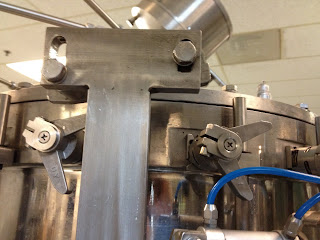Rinser Adjustments
The whole rinser assembly can be raised up or down to accommodate your bottle height.
The machine should be adjusted high enough to pick up the bottles at the proper height and set them back down smoothly.
Because the bottles can vary in height slightly and not all the rinser heads hang at exactly the same level you may have to have the bottles land a little high to accommodate the variations.
Height Adjustment:
- loosen the bolts on the three legs that support the rinser assembly.
- loosen the two bolts that secure the water line going to the top of the unit.
- under the machine - loosen the jam nut at the base for the threaded rod.
- turn the hand screw to raise or lower the rinser assembly.
- once you are happy with the height retighten the jam nut, leg and water line bolts.
Rotational Alignment:
The (4) bolts over the slotted holes toward the top center of the rinser are for adjusting the rotational alignment of the rinser.
The two bolt that attach each rinser head to the machine can loosened to optimize the entry of each bottle.
Bottle Jaws:
Before feeding bottles into the machine - as the machine rotates slowly - after it would have picked up a bottle - grab each pair of jaws - and squeeze closed.
If you feel movement:
- check for a weak spring - which may drop the bottle.
- if the spring is good and you still feel movement - you may need to lubricate the jaw arms at the pivot point.
- If the jaws do not open enough to accommodate the bottle neck - check the wheels that open the jaws.
as these ware thin the jaws open less.
- If new plastic jaws have been installed - and the wheel is good - the leading edge of the jaws may need to be ground back to accommodate the bottle neck.









